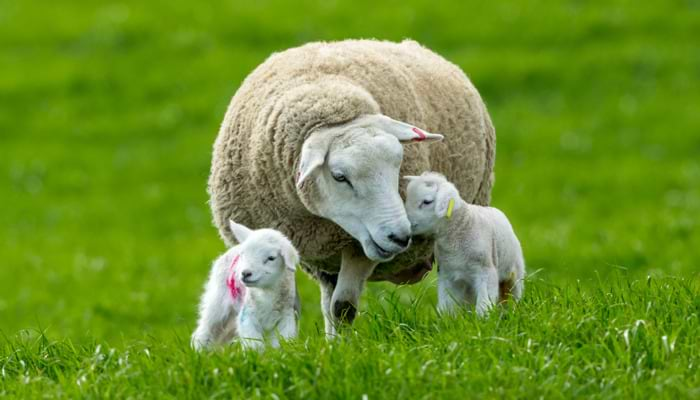
© Coatesy / Shutterstock.com
The welcoming signs of spring are in the air at last, bringing fresh hope following an uncertain and challenging winter. Spring officially starts on one of three days each year, during the period known as the spring equinox. According to astronomers, it arrives when the day and night are almost the same length. This occurs each year on 19th, 20th or 21st March. What are the common signs of spring? For many, a sea of bluebells denotes the dawning of spring. They bloom in their thousands in late March or early April. Look out for the oak, ash, rowan and beech trees coming into leaf, followed by the maple, silver birch and alder. Later in spring, the delicate blossoms from the crab apple and blackthorn trees start to appear. Nothing says spring to me quite like a field full of young lambs and hedgerows adorned with golden daffodils. Better weather encourages us to go for a walk. Gardens are an abundance of sunshine colours, and the spring air smells sweet and fresh. It’s definitely time to go outdoors and explore the countryside! What butterflies come out in spring? Butterflies will be out in greater numbers in March and April. One of the most colourful species in Britain is the brimstone butterfly. Big, bold and bright; its dairy yellow wings are the reason butterflies have the word "butter" in their name. They are among the first species to fly into our gardens on warm days throughout March and can be spotted in large numbers feeding on flowers. The male brimstone butterflies are more brightly coloured than the females and have the most stunning yellow wings, with an orange spot on the side. With paler, whitish-green wings, the female also has the trademark orange spot. As an essential part of spring and summer, both in our garden and in the wild; Britain has a total of about 60 butterfly species. Our rarest butterfly is the High Brown Fritillary, which is found in only a handful of sites in north-west England and Wales. Butterfly conservation projects are underway to preserve this delicate species. How does spring affect bees? The warm sun soon awakens the queen bumblebees, who need lots of nectar in March and April to build up their strength after the bleak winter. Spring is the time when the bees start searching for new places to build their colony. Once the queen bee has found a suitable place for a nest, she builds a mound from secreted wax and pollen and lays her first eggs of the year. That’s why you see more bees active in March and April. With more than 270 different bee species in Britain, of which 24 are bumblebees; they are social creatures that live in colonies, which vary in size, depending on the genus - there can be as many as 400 bees in a well-established colony. Bees transfer pollen between many flowering plants, keeping the cycle of life turning. We tend to take them for granted, but without bees, our countryside would be far less interesting and beautiful, as they pollinate around 80% of our wildflowers. What can you spot in your spring garden? March is a month full of spring promise, with new shoots pushing through the soil, daffodils blooming and song thrushes singing. Most of us have the urge to do some gardening, but if the weather is still a little chilly, take care when digging your garden that you don't disturb any hibernating animals, such as hedgehogs. Look out for catkins; the slim, cylindrical clusters of tiny flowers that enable certain species of trees to reproduce. Hanging from branches, they allow female flowers to be pollinated. You will also see more wild birds, so make sure they have plenty of food, as they are vulnerable at this time of year, particularly if it's been a harsh winter. They need extra nourishment, so they have the energy to stake out their territory, build their nests and prepare to breed. The Dawn Chorus starts in earnest in early March – with birds trying to attract mates and defend their territory. Early risers include song thrushes, skylarks and blackbirds. What can be seen on a coastal walk? As well as the spectacular views of sandy beaches, the sea and striking geological formations, you will also see plenty of flora and fauna on a coastal walk in the spring. Typical sights include an abundance of brightly coloured wildflowers such as poppies, scarlet pimpernels, harebells and pink pyramidal orchids. Certain coasts in the UK have their share of wildlife such as seals, terns, dolphins, curlews and oystercatchers. You might even spot a peregrine falcon hunting for food. Look out for cormorants flying overhead, as it's the breeding season for this stunning seabird. They thrive along the coast, as there is an abundance of food. Keep your eyes peeled and you might also spot butterfly species, such as the Chalkhill Blue. What can be seen on a woodland walk? Springtime in the UK's woodlands is a glorious time of year, with the wildflowers and hedges awaking from their winter slumber. Tawny owls, woodpeckers, tree creepers, kingfishers and chiffchaffs will greet you with their birdsong as you stroll along the woodland paths. Look out for wildflowers such as primroses, daffodils, wood anemones, lesser celandine, purple orchids and violets. The season of promise When nothing seems right and if all else fails, remember the many wonders of the British countryside - that should be enough to put a smile on your face!




